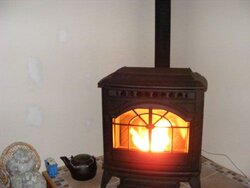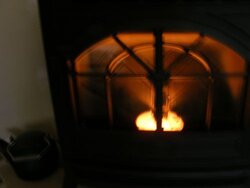welshcob
New Member
I managed to get my Quad Santa Fe roaring tonight, maybe the third time in a year, (after putting four ton of pellets through the little darling.) Anyhow, I had dumped the firepot when I got home from work and everything was cool, but an hour later it started to rumble big time, serious vibration noise and all. I shut down the thermostat and once I was satisfied it HAD shut down I went off to the dog training club for a couple hours to let things cool off. On my return I set out to clean the stove and immediately found the problem - clinkers had formed a bridge in the firepot, so pulling the dump rod didn't do the job, I had to stir it up a little bit with a screwdriver and then dump it. This happened once or twice last year, different pellets, its just a thing that can occur. Pulling that rod on the Quads is really easy but every once in awhile its not 100% effective. No big deal, just do a visual inspection to make sure the crud gets cleaned out.


 Can I hazard a novice guess? Because my issue is random what if just before the thermostat turned off the call light the augure had just dumped a good number of pellets (you know how sometimes it drops a few and other times a lot) then went into shutdown. If these last pellets were not completely burned and upon the next call for heat the stove dumps in its’ good share of startup pellets might there be a “random” time when I have too many pellets in the pot and have the accompaning “Ed Sullivan Fire” (really big fire) untill these pellets burned down? Center Tree stated after waiting 20-30 seconds his burt down to a normal fire. I am not so sure I have the courage to last that long given the noise and size of the fire, but I may try to steel myself for the 30 seconds to see if it clears. The problem is catching a random occurance.
Can I hazard a novice guess? Because my issue is random what if just before the thermostat turned off the call light the augure had just dumped a good number of pellets (you know how sometimes it drops a few and other times a lot) then went into shutdown. If these last pellets were not completely burned and upon the next call for heat the stove dumps in its’ good share of startup pellets might there be a “random” time when I have too many pellets in the pot and have the accompaning “Ed Sullivan Fire” (really big fire) untill these pellets burned down? Center Tree stated after waiting 20-30 seconds his burt down to a normal fire. I am not so sure I have the courage to last that long given the noise and size of the fire, but I may try to steel myself for the 30 seconds to see if it clears. The problem is catching a random occurance. ! They should not be that high even on HIGH setting! Some people have the feed rod closed as far as it will go. Don't be afraid to slow it down. Put it on HIGH and keep adjusting down to get the flame at 4", like people are trying to tell you.
! They should not be that high even on HIGH setting! Some people have the feed rod closed as far as it will go. Don't be afraid to slow it down. Put it on HIGH and keep adjusting down to get the flame at 4", like people are trying to tell you.
